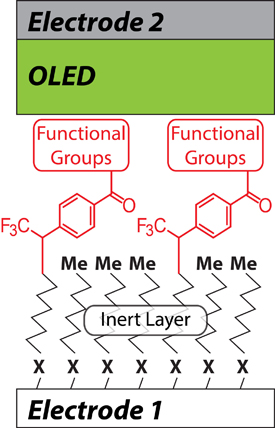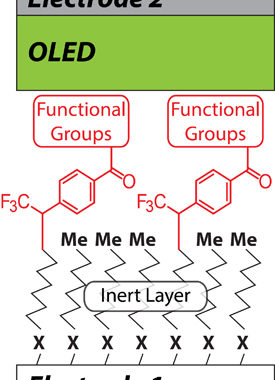As integrated circuits get smaller, past the current 20nm-22nm process technology, they increasingly come up against quantum mechanics quirks such as electron tunneling and current leakage. Chip designers and academic researchers mainly pursue the next nanometer threshold, in adherence to the ITRS (the International Technology Roadmap for Semiconductors), using all kinds of clever workarounds to get there. However, another segment of ambitious researchers have chosen to focus on fundamental redesigns to create circuits at the atomic scale. (For comparison’s sake, let’s recall that one nanometer is 50,000th of a hair width and a silicon atom has a diameter of .22 nanometers.)

Researchers from the University of Rochester and Duke University have achieved a breakthrough in this exciting space, using a bi-layered molecular interface to send an electric charge across a circuit one molecule wide. Their work appears in the April edition of the journal Advanced Material Interfaces.
Led by Alexander Shestopalov, an assistant professor of chemical engineering at the University of Rochester with a focus on unconventional nanoscale electronics, the team used a single layer of organic molecules to connect the positive and negative electrodes in a molecular-junction OLED (organic light-emitting diode).
One of the main problems that scientists face in developing circuits at the atomic scale is how to control the current flowing through the circuit. Shestopalov responded to the challenge by adding a second, inert layer of molecules. This inert layer acts like the plastic casing on electric wires that insulates the live wires from the surrounding environment.
“Until now, scientists have been unable to reliably direct a charge from one molecule to another,” said Shestopalov in an official release. “But that’s exactly what we need to do when working with electronic circuits that are one or two molecules thin.”
The inert layer is comprised of a microscopic chain of organic molecules. On top of that is the active layer, a one-molecule thin sheet of organic material. Following the wire analogy, the top layer conducts the charge while the lower inert layer insulates it, thus reducing interference.
Shestopalov was able to control the current by making small changes to the organic molecules’ functional groups – using some functional groups to accelerate the charge transfer and others to slow it down.
The ability to alter the functional group enables fine-tuning of the charge to support different applications. For example, an OLED may need a faster charge transfer to output a certain luminescence, while a biomedical injection device may require a slower rate for delicate procedures.
The accomplishment is a significant milestone for molecular electronic devices, however there is still work ahead, namely with respect to durability.
“The system we developed degrades quickly at high temperatures,” said Shestopalov. “What we need are devices that last for years, and that will take time to accomplish.”
The applications for such nanoscale circuitry are numerous, ranging from solar cells and other photovoltaics to drug delivery and bioimaging – not to mention the potential for atomic-scale computing.




























































